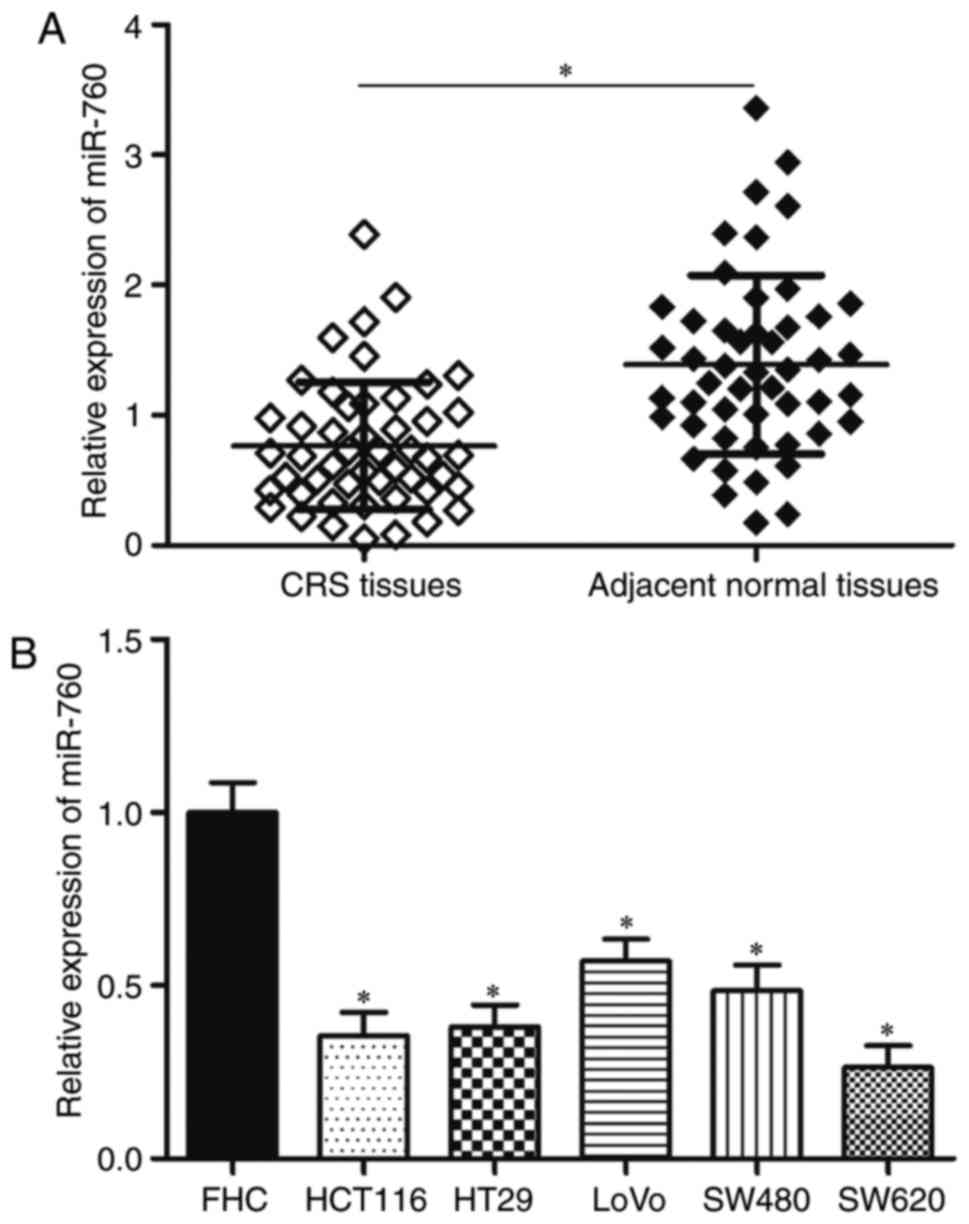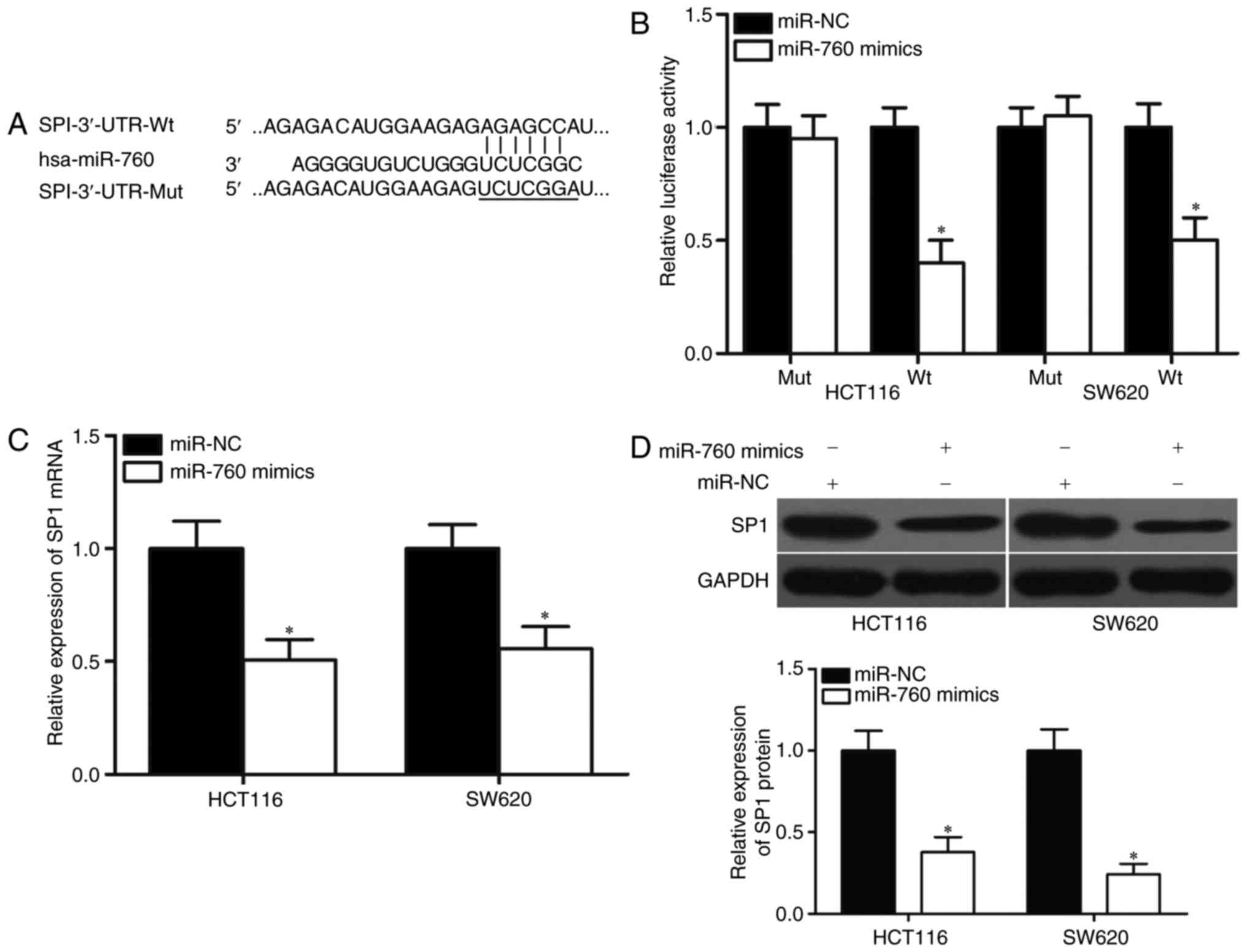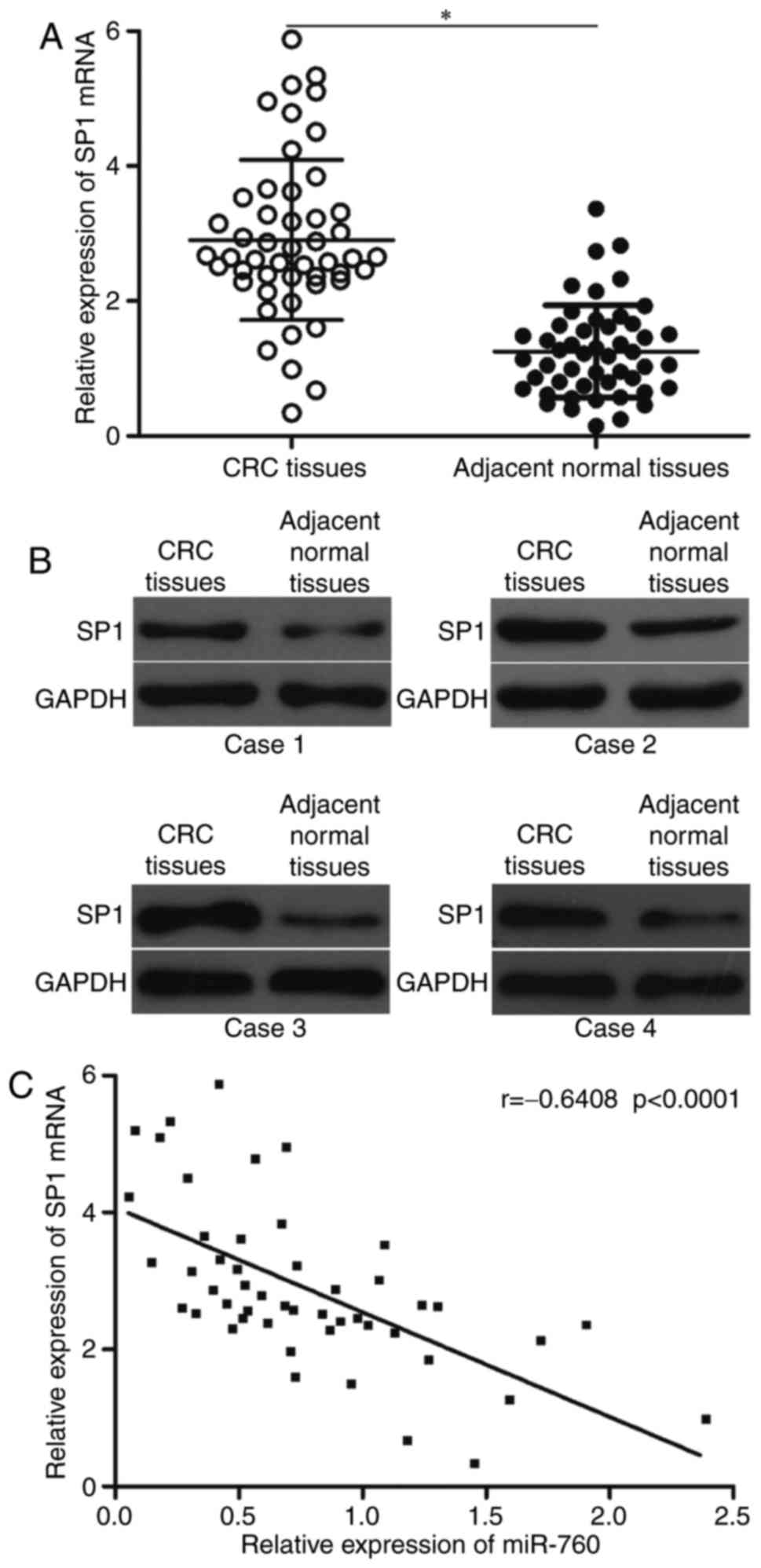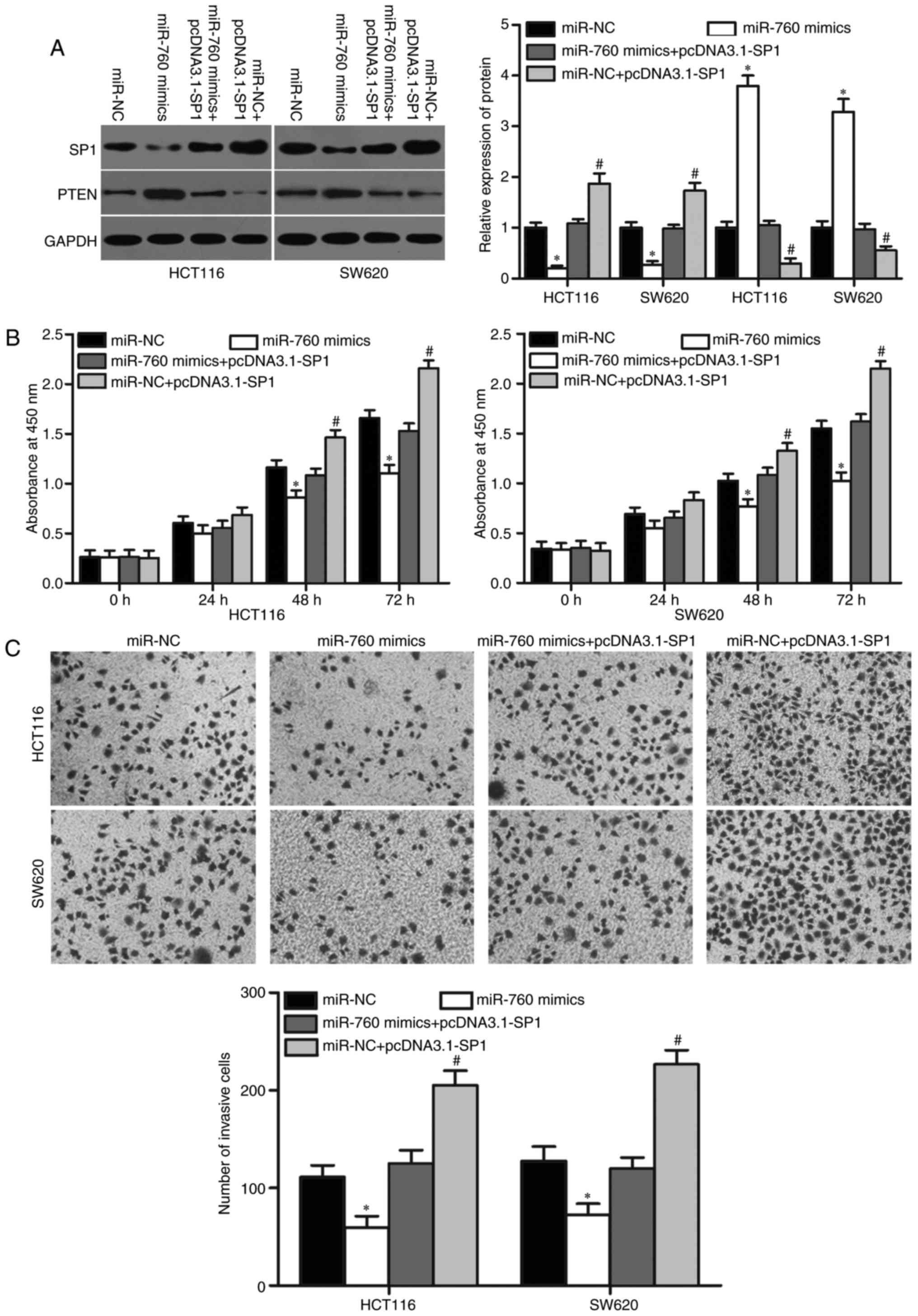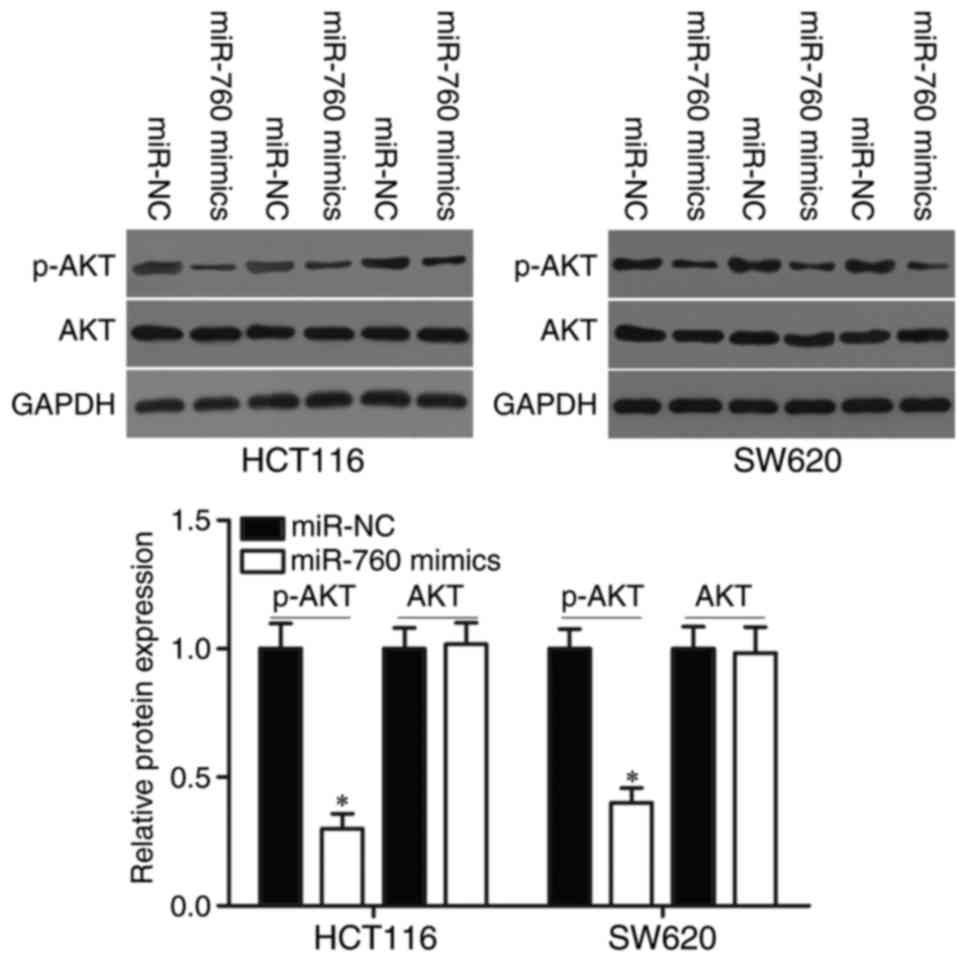MicroRNA‑760 inhibits cell proliferation and invasion of colorectal cancer by targeting the SP1‑mediated PTEN/AKT signalling pathway
Retraction in 10.3892/mmr.2022.12783
- Authors:
- Published online on: October 17, 2017 https://doi.org/10.3892/mmr.2017.7814
- Pages: 9692-9700
Abstract
Introduction
Colorectal cancer (CRC), one of the most commonly diagnosed cancers worldwide, is the third most prevalent and fourth most frequent cause of cancer-related mortality (1). CRC is the third most frequently reported cancer in males and the second most frequently reported cancer in females (2). Globally, approximately 1.36 million new CRC cases are diagnosed and 694,000 deaths due to CRC are recorded every year (3). Patient prognosis remains poor despite the remarkable progress in the diagnosis and treatment of CRC (4). Recurrence following curative surgery and metastasis are the main reasons for the unsatisfactory prognosis of CRC patients (5). Therefore, fully understanding the mechanisms that underlie CRC formation and progression is essential in identifying potential biomarkers for CRC and improving the prognosis and treatment of CRC patients.
MicroRNAs (miRNAs) constitute a large family of endogenous and small noncoding RNA molecules that are 18–24 nucleotides long (6). miRNAs negatively modulate the expression of corresponding target messenger RNAs by binding to their 3′-untranslated regions (3′-UTRs). This process causes translational repression or mRNA degradation (7). Bioinformatics studies have demonstrated that miRNAs account for approximately 1% of all human genes and could regulate approximately 60% of human protein-coding genes (8–10). miRNAs are aberrantly expressed in various types of human cancers, including CRC (11,12). MiRNA dysregulation is involved in tumor occurrence and progression by regulating numerous biological functions, such as cellular proliferation, cycle, differentiation, apoptosis, epithelial-mesenchymal transition (EMT), migration, invasion, metastasis, angiogenesis and chemoresistance (9,13,14). Increasing evidence has indicated that miRNAs act as oncogenes or tumour suppressors in tumorigenesis and tumor development by regulating corresponding target genes (15–17). Therefore, investigating the expression pattern and biological roles of miRNAs in CRC would provide novel and effective therapeutic targets for patients with this disease.
miR-760 is abnormally expressed in breast (18) and ovarian cancers (19). Plasma miR-760 expression is lower in CRC patients than in healthy participants (20). However, miR-760 expression, its roles and underlying regulatory mechanism in CRC tissues remain to be fully elucidated. Therefore, the present study aims to investigate the expression and roles of miR-760 in CRC and determine the underlying regulatory mechanism. The results of this study, for the first time, demonstrated that miR-760 was downregulated in CRC tissues and cell lines. The low expression levels of miR-760 were associated with the tumor size, lymph node metastasis and TNM stage of CRC. In addition, miR-760 upregulation suppressed CRC cell proliferation and invasion in vitro. Moreover, SP1 was confirmed to be a novel direct target gene of miR-760 in CRC cells. miR-760 was found to be participated in the regulation of PTEN/AKT pathway in CRC was the novelty of this research.
Materials and methods
Tissue samples
This study was approved by the Ethics Committee of Linyi Central Hospital. Written informed consents were also obtained from patients prior to sampling. The CRC tissues and matched adjacent normal tissues were surgically resected from 49 patients with CRC in the Department of General Surgery, Linyi Central Hospital, between April 2014 to March 2016. All these CRC patients did not undergo chemotherapy or radiotherapy before surgery. All tissue samples were immediately snap-frozen in liquid nitrogen and stored at −80°C until use.
Cell lines and transfection
Human CRC cell lines (HCT116, HT29, LoVo, SW480 and SW620) and normal human colon epithelium cell line FHC were acquired from American Type Culture Collection (Manassas, VA, USA). All cells were cultured in Dulbecco's modified Eagle's medium (DMEM) supplemented with 10% fetal bovine serum (FBS) (both from Gibco; Thermo Fisher Scientific, Inc., Waltham, MA, USA), 100 U/ml penicillin and 100 mg/ml streptomycin in a humidified incubator with a mixture of 5% CO2 at 37°C.
miR-760 mimics and corresponding negative control miRNA (miR-NC) were obtained from GenePharma (Shanghai, China). specificity protein 1 (SP1) overexpression plasmid, pcDNA3.1-SP1 and blank plasmid pcDNA3.1 were synthesized by Chinese Academy of Sciences (Changchun, China). Cells were seeded in 6-well plates with a density of 8×105 cells each well. After incubation overnight, cells were transfected with these oligonucleotides using Lipofectamine 2000 (Invitrogen; Thermo Fisher Scientific, Inc.), according to the manufacturer's instructions. Transfected cells were then incubated at 37°C with 5% CO2. After incubation 6 h, cell culture medium was replaced with fresh DMEM containing 10% FBS.
Reverse transcription-quantitative polymerase chain reaction (RT-qPCR)
Total RNA of clinical tissue specimens and cells were isolated with TRIzol reagent (Invitrogen; Thermo Fisher Scientific, Inc.), according to the manufacturer's instructions. To determine miR-760 (accession no. MI0005567) expression level, total RNA (1 µg) was reverse-transcribed to cDNA using TaqMan MicroRNA Reverse Transcription kit (Applied Biosystems; Thermo Fisher Scientific, Inc.). Real-time PCR was carried out with TaqMan MicroRNA PCR kit on the Applied Biosystems 7500 Sequence Detection system (both from Applied Biosystems; Thermo Fisher Scientific, Inc.). The reaction system contained 1 µl TaqMan® small RNA assay (20X), 1.33 µl cDNA, 10 µl TaqMan® Universal PCR Master Mix II (2X) and 7.67 µl nuclease-free water. The cycling conditions were as follows: 50°C for 2 min, 95°C for 10 min; 40 cycles of denaturation at 95°C for 15 sec; and annealing/extension at 60°C for 60 sec. To detect SP1 (accession no. NM_003109) mRNA expression, cDNA was synthesized using M-MLV reverse transcriptase (Fermentas; Thermo Fisher Scientific, Inc., Pittsburgh, PA, USA). The relative expression of SP1 mRNA was detected using SYBR Premix Ex Taq™ (Takara Biotechnology Co., Ltd., Dalian, China). The reaction system contained 10 µl SYBR Premix Ex Taq, 2 µl cDNA (200 ng), 0.8 µl forward primer, 0.8 µl reverse primer, 0.4 µl ROX reference dye and 6 µl ddH2O. The amplification was performed with cycling conditions as follows: 5 min at 95°C, followed by 40 cycles of 95°C for 30 sec and 65°C for 45 sec. U6 small nuclear RNA (U6) and glyceraldehyde-3-phosphate dehydrogenase (GAPDH) were used as endogenous control in the detection of miR-760 and SP1 mRNA, respectively. The primers were designed as follows: miR-760, 5′-GTCGAGCGGCTCTGGGTCTGTG-3′ (forward) and 5′-TCCAGTGCAGGGTCCGAGGT-3′ (reverse); U6, 5′-CTCGCTTCGGCAGCACA-3′ (forward) and 5′-AACGCTTCACGAATTTGCGT-3′ (reverse); SP1, 5′-TGGTGGGCAGTATGTTGT-3′ (forward) and 5′-GCTATTGGCATTGGTGAA−3′ (reverse); and GAPDH, 5′-AGAAGGCTGGGGCTCATTTG-3′ (forward) and 5′-AGGGGCCTCCACAGTCTTC-3′ (reverse). Relative expression levels were calculated using the 2−∆∆Ct method (21). Each assay was performed in triplicate and repeated three times.
Cell Counting Kit (CCK)8 assay
CCK8 assay was performed to measure cell proliferation. Transfected cells were collected at 24 h post-transfection, and seeded into 96-well plates at a density of 3×103 cells/well. Cells were then maintained at 37°C with 5% CO2 for 0, 24, 48 or 72 h. At these time-points, 10 µl of CCK8 solution (Dojindo Molecular Technologies, Kumamoto, Japan) were added into each well, and the cells were incubated for addition 2 h at 37°C. The absorbance at a wavelength of 450 nm was determined using Victor 3 Multi-Label microplate reader (PerkinElmer, Inc., Waltham, MA, USA). Each assay was performed in five parallel wells and repeated three times.
Cell invasion assay
Cell invasion assays were performed in 24-well Transwell® chambers with 8 µm pores (Costar; Corning Incorporated, Corning, NY, USA) coated with Matrigel (BD Biosciences, Franklin Lakes, NJ, USA). Transfected cells were harvested 48 h following transfection. Transfected cells (5.0×104) in FBS-free medium were added into the upper chamber, and 600 µl DMEM medium with 10% FBS was supplemented into the matched lower chamber. After 24 h incubation at 37°C with 5% CO2, the non-invading cells were wiped out carefully with cotton swabs. Cells that invaded to the bottom chamber were fixed with 100% methanol, stained with 0.1% crystal violet, washed in PBS and dried in air. The invasive cells were photographed and counted in five randomly selected visual fields under an inverted microscope (×200 magnifications; Olympus Corporation, Tokyo, Japan). Each assay was repeated three times.
Bioinformatics analysis
The potential target genes of miR-760 was predicted using TargetScan (www.targetscan.org/) and miRanda (www.microrna.org).
Luciferase reporter assay
The luciferase plasmids, including the psiCHECK2-SP1-3′-UTR-wild-type (Wt) and psiCHECK2-SP1-3′-UTR-mutant (Mut), were synthesized and obtained from GenePharma. For the luciferase reporter assays, cells were seeded into 24-well plates at a density of 60–70% confluence, and co-transfected with luciferase reporter plasmid, and miR-760 mimics or miR-NC using Lipofectamine 2000, according to the manufacturer's instructions. After 48 h of transfection, the firefly and Renilla luciferase activities were detected with Dual-Luciferase Reporter Assay system (Promega, Manheim, Germany) in accordance with the manufacturer's suggestions. Renilla luciferase activity was normalized to firefly luciferase activity. Each assay was repeated three times.
Western blotting
Whole protein extracts form tissues and cells were lysed by ice-cold radioimmunoprecipitation assay (RIPA) buffer (Beyotime Institute of Biotechnology, Haimen, China), according to the manufacturer's protocol. The concentration of total protein was measured using a BCA protein assay kit (Beyotime Institute of Biotechnology, Haimen, China). Equal amounts of protein were separated through a 10% sodium dodecyl sulfate-polyacrylamide gel electrophoresis (SDS-PAGE) gel and transferred onto nitrocellulose membranes (Millipore, Billerica, MA, USA).
The membranes were then blocked in 5% nonfat milk in TBST and incubated with primary antibodies overnight at 37°C: Mouse anti-human monoclonal SP1 antibody (1:1,000 dilution; sc-420), mouse anti-human monoclonal PTEN antibody (1:1,000 dilution; sc-7974), mouse anti-human monoclonal p-AKT antibody (1:1,000 dilution; sc-271966), mouse anti-human monoclonal AKT antibody (1:1,000 dilution; sc-56878), and mouse anti-human monoclonal GAPDH antibody (1:1,000 dilution; sc-32233) (all from Santa Cruz Biotechnology, Inc., Santa Cruz, CA, USA). After washing three times with TBST, the membranes were probed with a goat-anti-mouse horseradish peroxidase (HRP)-conjugated secondary antibody (1:5,000 dilution; sc-2005; Santa Cruz Biotechnology, Inc.). Protein bands were visualized by incubating the membranes with ECL detection kit (GE Healthcare Life Sciences, Chalfont, UK). Protein expression levels were normalized to GAPDH. Each assay was repeated three times.
Statistical analysis
Data are presented as the mean ± standard deviation and compared using SPSS software (version 13.0; SPSS, Inc., Chicago, IL, USA). The differences between two groups were analyzed using Students t-test, or assessed by one-way ANOVA when there were more than two groups. Student-Newman-Keuls test was used as a post hoc test following ANOVA. P<0.05 was considered to indicate a statistically significant difference.
Results
miR-760 is frequently downregulated in CRC tissues and cell lines
RT-qPCR was used to detect miR-760 expression levels in 49 CRC tissue samples and matching adjacent normal tissue samples. The results showed that miR-760 expression was lower in CRC tissues than in matching adjacent normal tissues (Fig. 1A, P<0.05). Then, miR-760 expression levels in the CRC cell lines HCT116, HT29, LoVo, SW480 and SW620 and in the normal human colon epithelial cell line FHC were determined. RT-qPCR results revealed that miR-760 was significantly lower in CRC cell lines compared with in FHC (Fig. 1B, P<0.05). These results suggested that miR-760 might play important roles in CRC progression.
miR-760 underexpression is correlated with the adverse clinicopathological parameters of CRC patients
To investigate the correlation of miR-760 expression with the clinicopathological factors of CRC, patients were divided into miR-760 low- and miR-760 high-expression groups based on the median expression of miR-760. As shown in Table I, low miR-760 expression was associated with the tumor size (P=0.015), lymph node metastasis (P=0.027) and TNM stage (P=0.006) of CRC. However, miR-760 expression was not correlated with sex (P=0.483), age (P=0.282), tumor location (P=0.680) or differentiation (P=0.470). These results suggested that miR-760 might be a prognostic biomarker for CRC patients.
Table I.Correlation between microRNA-760 expression and clinicopathological factors of colorectal cancer. |
miR-760 upregulation represses cell proliferation and invasion in CRC
Given that miR-760 is significantly downregulated in CRC, the tumor-suppressing roles of miR-760 in CRC were examined. HCT116 and SW620 cells, which both express low levels of endogenous miR-760, were selected for the transfection of miR-760 mimics. RT-qPCR was performed to determine transfection efficiency, and the results indicated that miR-760 was markedly upregulated in HCT116 and SW620 cells transfected with miR-760 mimics (Fig. 2A, P<0.05). The effects of miR-760 overexpression on the cell proliferation and invasion capacity of CRC were investigated. CCK8 assay results revealed that the ectopic expression of miR-760 attenuated HCT116 and SW620 cell proliferation compared with transfection with miR-NC (Fig. 2B, P<0.05). Cell invasion assays indicated that the restored expression of miR-760 in HCT116 and SW620 cells significantly inhibited cell invasion capacities compared with that in miR-NC groups (Fig. 2C, P<0.05). These results demonstrate that miR-760 may act as a tumor suppressor in CRC progression.
SP1 is a direct target of miR-760 in CRC
To determine the molecular mechanisms of miR-760 in the regulation of CRC cell proliferation and invasion, bioinformatics analysis was used to predict the potential target genes of miR-760. Among candidate genes, the SP1 gene (Fig. 3A), which is upregulated in CRC and is associated with CRC progression (22–27), was identified as a major target of miR-760 and selected for further analysis. Luciferase reporter assays were performed on HCT116 and SW620 cells transfected with luciferase plasmids that contained the wild-type or mutant miR-760-binding site in the SP1 3′-UTR, together with miR-760 mimics or miR-NC. As shown in Fig. 3B, luciferase activities in the reporter that contained the wild-type SP1 3′-UTR markedly decreased upon cotransfection with miR-760 mimics (P<0.05), whereas those in the reporter that contained the mutant binding site were unaffected.
Furthermore, the mRNA and protein levels of SP1 in HCT116 and SW620 cells that were transfected with miR-760 mimics or miR-NC were detected using RT-qPCR and Western blot. The results showed that miR-760 overexpression decreased SP1 expression in HCT116 and SW620 cells at the mRNA and protein levels (Fig. 3C and D, P<0.05). These findings suggested that SP1 is a direct target of miR-760 in CRC.
SP1 is upregulated in CRC tissues and its expression is inversely correlated with miR-760 expression
Given that SP1 is a direct target gene of miR-760 in CRC, its expression in CRC tissues was measured and its association with miR-760 expression levels was investigated. SP1 expression at the mRNA and protein levels significantly increased in CRC tissues compared with that in the matching adjacent normal tissues (Fig. 4A and B). In addition, Spearman's correlation analysis revealed an inverse association between miR-760 and SP1 mRNA levels in CRC tissues (Fig. 4C; r=-0.6408, P<0.0001).
SP1 reverses the tumor-suppressing effects of miR-760 on CRC cell proliferation and invasion
Given that SP1 is a direct target of miR-760, rescue experiments were performed to determine whether SP1 restoration could abolish the tumor-suppressing roles of miR-760 in CRC cells. HCT116 and SW620 cells were transfected with miR-760 mimics with or without SP1 overexpression (pcDNA3.1-SP1). Western blot analysis indicated that SP1 was downregulated in HCT116 and SW620 cells after transfection with miR-760 mimics; meanwhile, pcDNA3.1-SP1 cotransfection could recover SP1 expression (Fig. 5A, P<0.05) SP1 was identified as an important regulator of PTEN in cancer (28,29). Hence, we detected PTEN expression in above cells. As shown in Fig. 5A, PTEN expression was downregulated in HCT116 and SW620 cells transfected with miR-760 mimics, and pcDNA3.1-SP1 cotransfection could recover PTEN expression. Moreover, cotansfection of miR-NC and pcDNA3.1-SP1 could decrease PTEN expression (Fig. 5A, P<0.05).
Subsequently, CCK8 and cell invasion assays revealed that SP1 upregulation markedly reversed the inhibitory effects of miR-760 overexpression on cell proliferation (Fig. 5B, P<0.05) and invasion (Fig. 5C, P<0.05) in HCT116 and SW620 cells. Collectively, these results suggested that miR-760 partly inhibits CRC cell proliferation and invasion by regulating SP1.
MiR-760 regulates the PTEN/AKT pathway in CRC
We demonstrated that miR-760 participated in the regulation of PTEN expression in CRC cells. Therefore, AKT and p-AKT protein expression were measured in HCT116 and SW620 cells transfected with miR-760 mimics or miR-NC. As shown in Fig. 6, miR-760 overexpression decreased p-AKT expression without changing total AKT expression in HCT116 and SW620 cells (P<0.05). These results suggested that miR-760 directly targets SP1 and indirectly regulates the PTEN/AKT signalling pathways, thus playing tumor-suppressing roles in CRC.
Discussion
Dysregulated miRNAs have been recently implicated in the development and progression of different cancers (30–32). Further investigating the miRNAs involved in CRC formation and progression may lead to the development of more effective therapeutic strategies for CRC. Previous studies have reported that plasma miR-760 expression is lower in CRC patients than in healthy participants. Plasma miR-760 expression has a significant diagnostic value for advanced neoplasia (20). However, the biological roles and molecular mechanism of miR-760 expression in CRC tissues remain to be fully elucidated.
The present study revealed that miR-760 is significantly downregulated in CRC tissues and cell lines compared with in matching adjacent normal tissues and the normal human colon epithelial cell line FHC. Further correlation analysis showed that downregulated miR-760 expression is associated with the tumor size, lymph node metastasis and TNM stage of CRC. Cell function investigation showed that miR-760 upregulation inhibits CRC cell proliferation and invasion in vitro. SP1 was confirmed as a novel direct target of miR-760 in CRC. Moreover, miR-760 was found to regulate PTEN/AKT signalling pathway in CRC. These results suggested that miR-760 might serve as a novel biomarker and therapeutic target for CRC.
miR-760 is involved in the development and progress of certain cancers. For example, miR-760 expression is downregulated in doxorubicin (DOX)-resistant MCF-7/DOX cells and in chemoresistant breast cancer tissues. MiR-760 overexpression increases the chemosensitivity of breast cancer cells to anticancer agents. Additionally, the restored expression of miR-760 decreases the expression level of Nanog, a transcriptional factor involved in chemoresistance, thus reversing EMT in breast cancer cells (33). Han et al reported that miR-760 upregulation represses the subpopulation of cancer stem cells and the proliferation and migration of breast cancer cells (18). miR-760 is upregulated in the tumor tissues and cell lines of ovarian cancer. The high level of miR-760 expression is associated with an aggressive phenotype and poor prognosis in ovarian cancer. miR-760 acts as an oncogene in ovarian cancer by promoting cellular proliferation (19). These findings suggest that miR-760 is a potential target for the treatment of these cancers.
miRNAs negatively regulate their target genes by binding to the 3′UTR. Therefore, identifying the direct target genes of miR-760 is important in understanding the roles of miR-760 in tumorigenesis and tumor development. Several miR-760 targets, including RHOB (34), ANGOTL4 (34), ABCA1 (34) and NANOG (18) in breast cancer and PHLPP2 (19) in ovarian cancer, have been identified. In this study, SP1 was identified as a novel and functional target of miR-760 in CRC. SP1, a sequence-specific DNA-binding protein, is located at 12q13.1 and encodes a protein of 785 amino acids (35). SP1 is highly expressed in multiple types of human cancers, such as gastric cancer (36), hepatocellular carcinomas (37), prostate cancer (38), thyroid cancer (39), breast cancer (40), pancreatic cancer (41) and lung cancer (23). SP1 plays important roles in numerous pathophysiological processes, such as cell growth, differentiation, apoptosis, survival, metastasis and invasion (42). SP1 expression is increased in CRC tumor tissues (27). Subsequent functional assays have demonstrated that SP1 acts as an oncogene in CRC progression by regulating cell proliferation, apoptosis and metastasis (22–26). Therefore, SP1 may be developed as a therapeutic target for the suppression of tumorigenesis and tumor development in CRC.
In conclusion, this research demonstrated that miR-760 is downregulated in CRC and is markedly associated with cancer development. The restored expression of miR-760 in CRC cells inhibits cell proliferation and invasion through the regulation of SP1/PTEN/AKT signalling pathways, thus indicating that miR-760 has a therapeutic value in CRC. However, future studies are needed to investigate the feasibility of exploiting the miR-760/SP1 pathway in a therapeutic approach for CRC. The absence of the normal colon epithelium cell line (FHC) as a control group may have been a weakness of the study, and that this is something that will be included in future studies.
References
|
Center MM, Jemal A, Smith RA and Ward E: Worldwide variations in colorectal cancer. CA Cancer J Clin. 59:366–378. 2009. View Article : Google Scholar : PubMed/NCBI | |
|
Ferlay J, Shin HR, Bray F, Forman D, Mathers C and Parkin DM: Estimates of worldwide burden of cancer in 2008: GLOBOCAN 2008. Int J Cancer. 127:2893–2917. 2010. View Article : Google Scholar : PubMed/NCBI | |
|
Ferlay J, Soerjomataram I, Dikshit R, Eser S, Mathers C, Rebelo M, Parkin DM, Forman D and Bray F: Cancer incidence and mortality worldwide: Sources, methods and major patterns in GLOBOCAN 2012. Int J Cancer. 136:E359–E386. 2015. View Article : Google Scholar : PubMed/NCBI | |
|
Haggar FA and Boushey RP: Colorectal cancer epidemiology: Incidence, mortality, survival, and risk factors. Clin Colon Rectal Surg. 22:191–197. 2009. View Article : Google Scholar : PubMed/NCBI | |
|
Manfredi S, Lepage C, Hatem C, Coatmeur O, Faivre J and Bouvier AM: Epidemiology and management of liver metastases from colorectal cancer. Ann Surg. 244:254–259. 2006. View Article : Google Scholar : PubMed/NCBI | |
|
Krol J, Loedige I and Filipowicz W: The widespread regulation of microRNA biogenesis, function and decay. Nat Rev Genet. 11:597–610. 2010.PubMed/NCBI | |
|
Bartel DP: MicroRNAs: Genomics, biogenesis, mechanism, and function. Cell. 116:281–297. 2004. View Article : Google Scholar : PubMed/NCBI | |
|
Lim LP, Glasner ME, Yekta S, Burge CB and Bartel DP: Vertebrate microRNA genes. Science. 299:15402003. View Article : Google Scholar : PubMed/NCBI | |
|
Calin GA and Croce CM: MicroRNA signatures in human cancers. Nat Rev Cancer. 6:857–866. 2006. View Article : Google Scholar : PubMed/NCBI | |
|
Lewis BP, Burge CB and Bartel DP: Conserved seed pairing, often flanked by adenosines, indicates that thousands of human genes are microRNA targets. Cell. 120:15–20. 2005. View Article : Google Scholar : PubMed/NCBI | |
|
Kloosterman WP and Plasterk RH: The diverse functions of microRNAs in animal development and disease. Dev Cell. 11:441–450. 2006. View Article : Google Scholar : PubMed/NCBI | |
|
Oliveto S, Mancino M, Manfrini N and Biffo S: Role of microRNAs in translation regulation and cancer. World J Biol Chem. 8:45–56. 2017. View Article : Google Scholar : PubMed/NCBI | |
|
Esquela-Kerscher A and Slack FJ: Oncomirs - microRNAs with a role in cancer. Nat Rev Cancer. 6:259–269. 2006. View Article : Google Scholar : PubMed/NCBI | |
|
Manikandan J, Aarthi JJ, Kumar SD and Pushparaj PN: Oncomirs: The potential role of non-coding microRNAs in understanding cancer. Bioinformation. 2:330–334. 2008. View Article : Google Scholar : PubMed/NCBI | |
|
Li W, Chen A, Xiong L, Chen T, Tao F, Lu Y, He Q, Zhao L, Ou R and Xu Y: miR-133a acts as a tumor suppressor in colorectal cancer by targeting eIF4A1. Tumour Biol. 39:10104283176983892017.PubMed/NCBI | |
|
Ding L, Yu LL, Han N and Zhang BT: miR-141 promotes colon cancer cell proliferation by inhibiting MAP2K4. Oncol Lett. 13:1665–1671. 2017.PubMed/NCBI | |
|
Quan Y, Song Q, Wang J, Zhao L, Lv J and Gong S: MiR-1202 functions as a tumor suppressor in glioma cells by targeting Rab1A. Tumour Biol. 39:10104283176975652017. View Article : Google Scholar : PubMed/NCBI | |
|
Han ML, Wang F, Gu YT, Pei XH, Ge X, Guo GC, Li L, Duan X, Zhu MZ and Wang YM: MicroR-760 suppresses cancer stem cell subpopulation and breast cancer cell proliferation and metastasis: By down-regulating NANOG. Biomed Pharmacother. 80:304–310. 2016. View Article : Google Scholar : PubMed/NCBI | |
|
Liao Y, Deng Y, Liu J, Ye Z, You Z, Yao S and He S: MiR-760 overexpression promotes proliferation in ovarian cancer by downregulation of PHLPP2 expression. Gynecol Oncol. 143:655–663. 2016. View Article : Google Scholar : PubMed/NCBI | |
|
Wang Q, Huang Z, Ni S, Xiao X, Xu Q, Wang L, Huang D, Tan C, Sheng W and Du X: Plasma miR-601 and miR-760 are novel biomarkers for the early detection of colorectal cancer. PLoS One. 7:e443982012. View Article : Google Scholar : PubMed/NCBI | |
|
Livak KJ and Schmittgen TD: Analysis of relative gene expression data using real-time quantitative PCR and the 2(-Delta Delta C(T)) method. Methods. 25:402–408. 2001. View Article : Google Scholar : PubMed/NCBI | |
|
Bajpai R and Nagaraju GP: Specificity protein 1: Its role in colorectal cancer progression and metastasis. Crit Rev Oncol Hematol. 113:1–7. 2017. View Article : Google Scholar : PubMed/NCBI | |
|
Wang X, Wang J, Lin S, Geng Y, Wang J and Jiang B: Sp1 is involved in H2O2-induced PUMA gene expression and apoptosis in colorectal cancer cells. J Exp Clin Cancer Res. 27:442008. View Article : Google Scholar : PubMed/NCBI | |
|
Dong W, Shen R, Wang Q, Gao Y, Qi X, Jiang H, Yao J, Lin X, Wu Y and Wang L: Sp1 upregulates expression of TRF2 and TRF2 inhibition reduces tumorigenesis in human colorectal carcinoma cells. Cancer Biol Ther. 8:2166–2174. 2009. View Article : Google Scholar : PubMed/NCBI | |
|
Zhao Y, Zhang W, Guo Z, Ma F, Wu Y, Bai Y, Gong W, Chen Y, Cheng T, Zhi F, et al: Inhibition of the transcription factor Sp1 suppresses colon cancer stem cell growth and induces apoptosis in vitro and in nude mouse xenografts. Oncol Rep. 30:1782–1792. 2013. View Article : Google Scholar : PubMed/NCBI | |
|
Yu MH and Zhang W: TEAD1 enhances proliferation via activating SP1 in colorectal cancer. Biomed Pharmacother. 83:496–501. 2016. View Article : Google Scholar : PubMed/NCBI | |
|
Hosoi Y, Watanabe T, Nakagawa K, Matsumoto Y, Enomoto A, Morita A, Nagawa H and Suzuki N: Up-regulation of DNA-dependent protein kinase activity and Sp1 in colorectal cancer. Int J Oncol. 25:461–468. 2004.PubMed/NCBI | |
|
Kou XX, Hao T, Meng Z, Zhou YH and Gan YH: Acetylated Sp1 inhibits PTEN expression through binding to PTEN core promoter and recruitment of HDAC1 and promotes cancer cell migration and invasion. Carcinogenesis. 34:58–67. 2013. View Article : Google Scholar : PubMed/NCBI | |
|
Xia SS, Zhang GJ, Liu ZL, Tian HP, He Y, Meng CY, Li LF, Wang ZW and Zhou T: MicroRNA-22 suppresses the growth, migration and invasion of colorectal cancer cells through a Sp1 negative feedback loop. Oncotarget. 8:36266–36278. 2017.PubMed/NCBI | |
|
Garzon R, Calin GA and Croce CM: MicroRNAs in cancer. Annu Rev Med. 60:167–179. 2009. View Article : Google Scholar : PubMed/NCBI | |
|
Hwang HW and Mendell JT: MicroRNAs in cell proliferation, cell death, and tumorigenesis. Br J Cancer. 96 Suppl:R40–R44. 2007.PubMed/NCBI | |
|
Volinia S, Calin GA, Liu CG, Ambs S, Cimmino A, Petrocca F, Visone R, Iorio M, Roldo C, Ferracin M, et al: A microRNA expression signature of human solid tumors defines cancer gene targets. Proc Natl Acad Sci USA. 103:pp. 2257–2261. 2006; View Article : Google Scholar : PubMed/NCBI | |
|
Hu SH, Wang CH, Huang ZJ, Liu F, Xu CW, Li XL and Chen GQ: miR-760 mediates chemoresistance through inhibition of epithelial mesenchymal transition in breast cancer cells. Eur Rev Med Pharmacol Sci. 20:5002–5008. 2016.PubMed/NCBI | |
|
Lv J, Fu Z, Shi M, Xia K, Ji C, Xu P, Lv M, Pan B, Dai L and Xie H: Systematic analysis of gene expression pattern in has-miR-760 overexpressed resistance of the MCF-7 human breast cancer cell to doxorubicin. Biomed Pharmacother. 69:162–169. 2015. View Article : Google Scholar : PubMed/NCBI | |
|
Chang WC and Hung JJ: Functional role of post-translational modifications of Sp1 in tumorigenesis. J Biomed Sci. 19:942012. View Article : Google Scholar : PubMed/NCBI | |
|
Xu Y, Zhao F, Wang Z, Song Y, Luo Y, Zhang X, Jiang L, Sun Z, Miao Z and Xu H: MicroRNA-335 acts as a metastasis suppressor in gastric cancer by targeting Bcl-w and specificity protein 1. Oncogene. 31:1398–1407. 2012. View Article : Google Scholar : PubMed/NCBI | |
|
Yin P, Zhao C, Li Z, Mei C, Yao W, Liu Y, Li N, Qi J, Wang L, Shi Y, et al: Sp1 is involved in regulation of cystathionine γ-lyase gene expression and biological function by PI3K/Akt pathway in human hepatocellular carcinoma cell lines. Cell Signal. 24:1229–1240. 2012. View Article : Google Scholar : PubMed/NCBI | |
|
Sankpal UT, Goodison S, Abdelrahim M and Basha R: Targeting Sp1 transcription factors in prostate cancer therapy. Med Chem. 7:518–525. 2011. View Article : Google Scholar : PubMed/NCBI | |
|
Bonofiglio D, Qi H, Gabriele S, Catalano S, Aquila S, Belmonte M and Ando S: Peroxisome proliferator-activated receptor gamma inhibits follicular and anaplastic thyroid carcinoma cells growth by upregulating p21Cip1/WAF1 gene in a Sp1-dependent manner. Endocr Relat Cancer. 15:545–557. 2008. View Article : Google Scholar : PubMed/NCBI | |
|
Yue L, Li L, Liu F, Hu N, Zhang W, Bai X, Li Y, Zhang Y, Fu L, Zhang X and Ye L: The oncoprotein HBXIP activates transcriptional coregulatory protein LMO4 via Sp1 to promote proliferation of breast cancer cells. Carcinogenesis. 34:927–935. 2013. View Article : Google Scholar : PubMed/NCBI | |
|
Huang C and Xie K: Crosstalk of Sp1 and Stat3 signaling in pancreatic cancer pathogenesis. Cytokine Growth Factor Rev. 23:25–35. 2012. View Article : Google Scholar : PubMed/NCBI | |
|
Hsu TI, Wang MC, Chen SY, Yeh YM, Su WC, Chang WC and Hung JJ: Sp1 expression regulates lung tumor progression. Oncogene. 31:3973–3988. 2012. View Article : Google Scholar : PubMed/NCBI |



